Fault Detection and Classification (FDC) Market Size, Share, Statistics and Industry Growth Analysis Report by offering type (Software, hardware, services), Application (Manufacturing, Packaging), end use (Automotive, Electronics & Semiconductor, Metal & Machinery) and Region - Global Forecast to 2028
[257 Pages Report] The global fault detection and classification market size was valued at USD 4.4 billion in 2022 and is projected to reach USD 7.4 billion by 2028; it is expected to register a CAGR of 8.9% during the forecast period. Stringent health and safety measures imposed by governments and standards organizations on global manufacturing firms and Strong focus of manufacturers on automating quality control and quality assurance processes are among the factors driving the growth of fault detection and classification market.
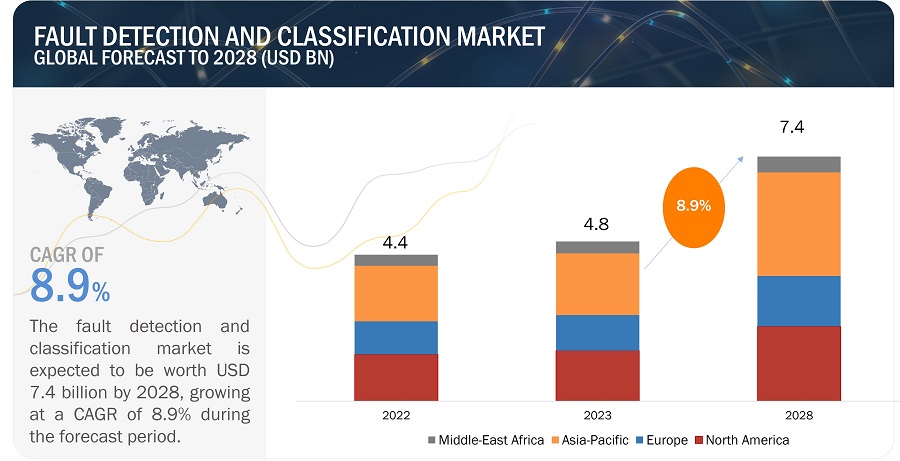
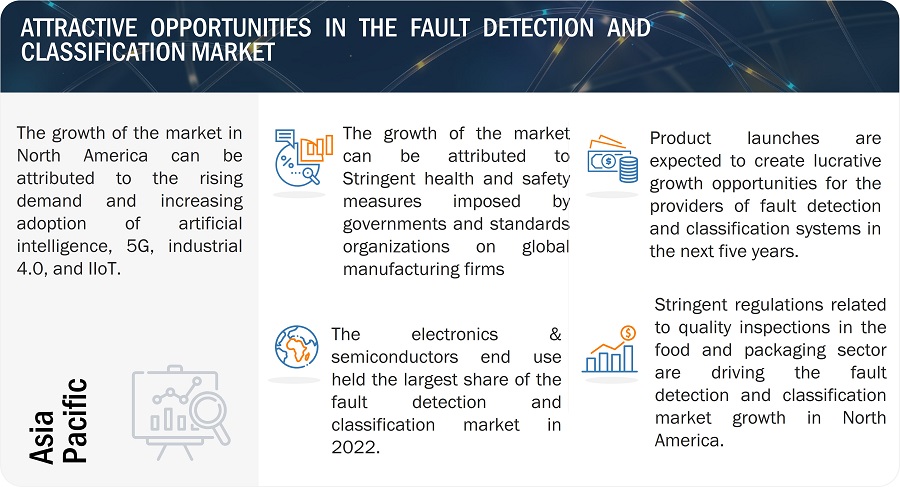
Fault Detection and Classification (FDC) Market Statistics Forecast to 2028
To know about the assumptions considered for the study, Request for Free Sample Report
Market Dynamics:
Driver: The increased complexity of systems
The rapid advancement of technology has led to increasingly complex systems across various industries. This complexity presents both opportunities and challenges, particularly in maintaining system reliability and efficiency. With increased complexity comes heightened challenges. Traditional manual monitoring and diagnosis no longer suffice, as the intricacies of these systems surpass human capacity. As systems become more intricate, the need for effective fault detection and classification (FDC) becomes paramount. FDC systems typically use a combination of sensors, data analytics, and machine learning algorithms to detect and classify faults. The sensors collect data from the system, which is then analyzed by the data analytics algorithms to identify any deviations from normal operating conditions. By continuously assessing data, these systems establish baselines for normal operation and identify deviations. Upon detecting anomalies, they employ classification algorithms to categorize faults, enabling swift responses.
The relentless rise in the complexity of modern systems necessitates innovative approaches to ensure their seamless functioning. Fault detection and classification systems stand as beacons of technological advancement, offering real-time monitoring, rapid fault identification, and informed decision-making. As industries embrace these solutions, they enhance their operational efficiency, safeguard their personnel and assets, and position themselves at the forefront of a future where complexity is not a challenge but an opportunity. In a world of intricate interconnections, FDC emerges as a cornerstone for sustained progress.
Restraint: Dearth of skilled professionals in manufacturing factories
In the manufacturing industry, there is a tremendous reliance on human experience and human senses. However, recently, the shortage of skilled professionals has become a more critical issue; therefore, automation of manufacturing, assembly, product testing and inspection, and transportation processes that depend on people has become an urgent task for businesses. On account of this, companies across industries embrace industrial automation with the growing use of fault detection and classification systems, machine vision systems, etc., to improve operational efficiency and performance, reduce waste and conserve natural resources, and reach new markets and audiences, but factories embracing machine vision technology would require more complex skill sets, and it could be difficult for lower/semi-skilled, less-educated workers to access opportunities.
Machine vision systems deployed to eliminate the defects require skilled professionals capable of deciphering machine signals on a dashboard and work together with collaborative robots on which machine vision systems are mounted.
Furthermore, economic growth largely depends on the productivity of the workforce. The current challenge is to promote lifelong learning, particularly among the elderly and economically active people. For example, China and Japan will face rapid population aging in the coming decades, necessitating the maintenance, and upgrading of a growing pool of mature and older workers, in addition to making further progress in formal education. Secondly, the growing younger generation will continue to strain both education and training capacities and job creation rates as more young people enter the job market. Young people with low skill levels are having difficulty finding work everywhere. In nearly every industry, there are now more open jobs than people looking for work. There are 1.06 job openings for every unemployed worker in the manufacturing industry. On average, 25% of workers in the manufacturing sector worldwide are underqualified.
Fault detection and classification systems with high-end and frequently changing features necessitate highly skilled individuals. An unskilled worker may be unable to carry out the operations and may impede the operation of the fault detection and classification system, resulting in false detection or a defect going undetected by the system. The shortage of skilled professionals can cause companies in various industries to shy away from fault detection and classification systems, proving a market restraint.
Opportunity: Increasing adoption of artificial intelligence (AI) technology
Quality control is one of the most important factors in manufacturing. Inspecting each product manually is costly, in terms of time and effort, creating bottlenecks caused by delayed production. In many cases, defects can be easily missed by the human eye or even by industry experts, resulting in decreased quality of an individual component or a defective final product that must be scrapped. Defect rates can often increase with more complex manufacturing systems. Recently, manufacturers have been focused on adopting advanced technologies, such as AI and deep learning, on transforming production processes and faster inspection of products and prompt detection of defects. The combination of software, use of deep learning technology, the power of parallel processing, and easy-to-use tools are core parameters of this transformation.
AI-based FDC tools/systems are superior to manual inspection in tracking products on the assembly lines, delivering significantly higher precision rates, enhanced product quality, increased productivity, higher throughput, and lower production costs. AI-based fault detection and classification systems used for quality control utilize machine learning technology so that defect prediction models can autonomously learn and make inferences from the manufacturer’s data. These models can shortlist important features and create new implicit rules to determine which combinations of features impact the overall product quality. Autonomous fault detection and classification systems deliver improved efficiency and accuracy, which constantly adjust to detect new types of defects across industries and verticals. Production yield and customer satisfaction largely depend on AI-based quality control for wide application areas ranging from nanometric semiconductors to huge engine parts of a commercial airplane. Traditional fault detection and classification systems cannot evaluate complex objects or products with high variations as easily as human operators; however, an AI-based fault detection and classification system can effortlessly find and compare defects with high variability.
AI-based fault detection and classification systems provide significant benefits to manufacturers:
- Early error detection, preventing defective parts from moving down the production line
- Increased production volume without sacrificing quality
- Tracking historical data to pinpoint issues and improve future production processes
- Optimized incoming material inspection
- Reaching, and often surpassing, human-level accuracy
These technologies enable the development of sophisticated algorithms capable of learning from historical data and adapting to changing conditions. This leads to higher accuracy in fault detection and classification and reduces false positives.
Furthermore, various companies are heavily investing in R&D activities to offer innovative and technologically advanced products and solutions in the fault detection and classification market. For instance, in July 203, Microsoft collaborated with Birlasoft to Establish Generative AI Centre of Excellence, Shares Rebound After Announcement. Birlasoft will utilize Azure OpenAI Service features for product design, process optimization, quality and defect detection, predictive maintenance, and digital twins for the manufacturing sector
Challenge: Complexity in implementation of fault detection and classification solution and technologies
Increasing competition, growing instability in the business arena, and ongoing technological advancements necessitate to change the way manufacturing enterprises operate and expand their business. To achieve the aforementioned objectives, organizations need to accomplish seamless production. Fault detection and classification systems are used in a variety of applications, including manufacturing, healthcare, and packaging. Each application has its own quirks, and technological advancements add complexity to manufacturing processes on a daily basis. Fault detection and classification systems face the challenge of meeting the diverse and ever-changing needs of various applications. Whether it is a camera, an optics, software, or a frame grabber, versatile solutions can be quickly developed to tackle a wide range of tasks by using multipurpose components. The need of the hour is to simplify the integration process with regard to different components of fault detection and classification systems and the production lines at application sites. With increasing efforts being put into boosting the convenience of installing and handling all technical systems, players in the fault detection and classification market must look to address these requirements by coming up with plug-and-play solutions.
Fault Detection And Classification Market Ecosystem
Prominent companies in this market include well-established, financially stable providers of fault detection and classification systems. These companies have been operating in the market for several years and possess a diversified product portfolio, state-of-the-art technologies, and strong global sales and marketing networks. Prominent companies in this market include Keyence Corporation (Japan), Cognex Corporation (US), KLA Corporation (US), Teledyne Technologies (US), OMRON Corporation (Japan), Microsoft (US), Tokyo Electron Limited (Japan), Siemens (Germany), Amazon Web Services, Inc. (US), Synopsys, Inc. (US)
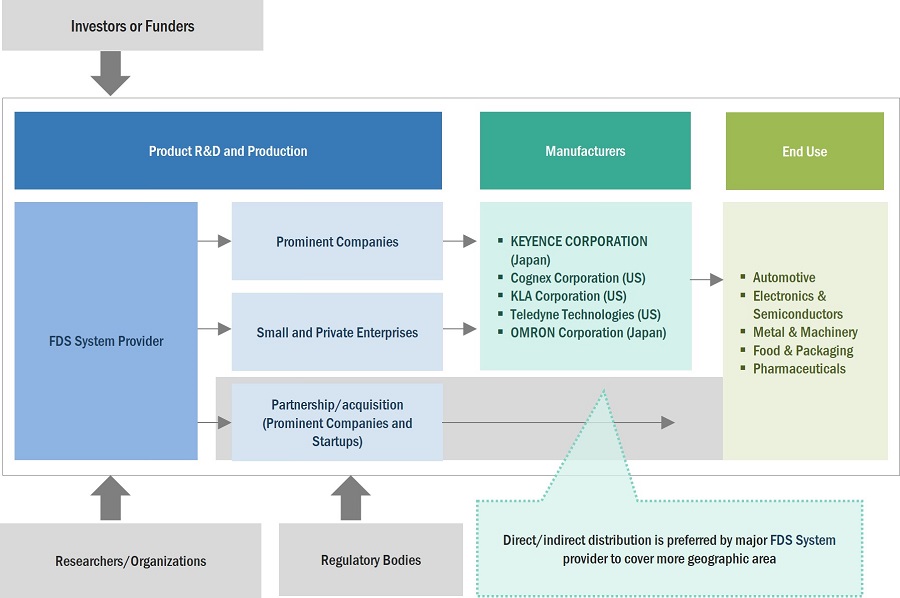
By end use, the automotive segment is expected to grow with the highest CAGR from 2023 to 2028
The fault detection and classification market for automotive end use is expected to grow at the highest CAGR from 2023 to 2028. The growth of the segment is attributed to the the increasing complexity of vehicles, stringent safety regulations, demand for improved fuel efficiency, need to reduce downtime, and advances in technology. Also, Automotive manufacturers are under immense pressure to meet safety standards and deliver vehicles with low defect rates. FDC systems provide a proactive approach to identifying issues early in the manufacturing process, reducing the likelihood of recalls and safety-related defects. This not only saves manufacturers from costly recalls but also enhances their reputation for producing safe and reliable vehicles.
By offering, the software segment is expected to grow with a highest CAGR in 2028.
Software offering is expected to exhibit a highest CAGR in the fault detection and classification market in 2028. The growth can be attributed as fault detection and classification software offers greater flexibility and adaptability compared to hardware-based solutions. It can be easily updated, modified, or reconfigured to accommodate changes in processes, equipment, or data sources. This flexibility is crucial in industries with rapidly evolving technologies or dynamic operational environments, as it allows organizations to stay agile and responsive to new challenges. Also, Software-based FDC solutions can scale easily to accommodate growing data volumes and expanding operations. As businesses expand, they can simply upgrade their software infrastructure to handle increased data sources and analytical demands.
By hardware, camera segment is expected to grow with a highest CAGR during the forecast period.
Cameras is expected to exhibit a highest CAGR in the fault detection and classification market during the forecast period. The growth of fault detection and classification cameras is driven by their advanced imaging technology, real-time monitoring capabilities, cost efficiency, applicability across industries, regulatory compliance, data analytics potential, and alignment with Industry 4.0 trends. As industries strive for higher product quality, efficiency, and competitiveness, FDC cameras continue to play a pivotal role in meeting these objectives.
In 2028, Asia Pacific is projected to hold the highest CAGR of the overall fault detection and classification market
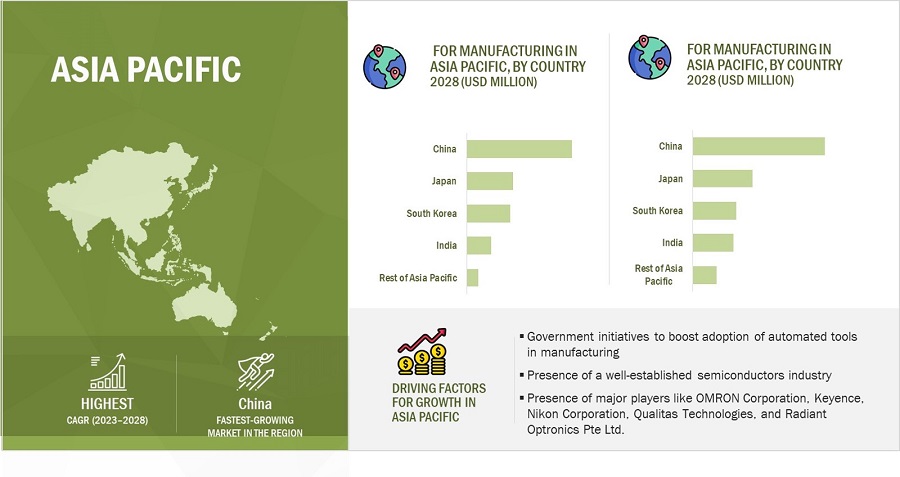
Fault Detection and Classification (FDC) Market Statistics by Region
To know about the assumptions considered for the study, download the pdf brochure
In 2028, Asia Pacific is projected to account for the largest share of the fault detection and classification market. Asia pacific has witnessed substantial industrial expansion, particularly in manufacturing, automotive, electronics, and semiconductor industries. As these sectors continue to grow, the need for FDC becomes paramount to maintain product quality, optimize production processes, and ensure operational efficiency.
Top Fault Detection and Classification (FDC) Companies - Key Market Players:
Keyence Corporation (Japan), Cognex Corporation (US), KLA Corporation (US), Teledyne Technologies (US), OMRON Corporation (Japan), Microsoft (US), Tokyo Electron Limited (Japan), Siemens (Germany), Amazon Web Services, Inc. (US), Synopsys, Inc. (US) are some of the key players in the fault detection and classification companies.
Fault Detection and Classification (FDC) Market Report Scope :
|
Report Metric |
Details |
| Estimated Market Size | USD 4.4 Billion |
| Projected Market Size | USD 7.4 Billion |
| Growth Rate | 8.9 % |
|
Market Size Availability for Years |
2019–2028 |
|
Base Year |
2022 |
|
Forecast Period |
2023–2028 |
|
Forecast Units |
Value (USD) |
|
Segments Covered |
By Fault types, technology, offering, application, end-use, and region |
|
Geographies Covered |
North America, Europe, Asia Pacific, and RoW |
|
Companies Covered |
Keyence Corporation (Japan), Cognex Corporation (US), KLA Corporation (US), Teledyne Technologies (US), OMRON Corporation (Japan), Microsoft (US), Tokyo Electron Limited (Japan), Siemens (Germany), Amazon Web Services, Inc. (US), Synopsys, Inc. (US) are some of the key players in the fault detection and classification market. |
Fault Detection and Classification (FDC) Market Highlights
This research report categorizes the fault detection and classification market based on by fault types, technology, offering, application, end-use, and region.
|
Segment |
Subsegment |
|
By Fault Type |
|
|
By Technique/Technology |
|
|
By Offering |
|
|
By Application |
|
|
By End Use |
|
|
By Geography |
|
Recent Developments in Fault Detection and Classification (FDC) Industry
- In August 2023, Synopsys, Inc. launched Synopsys Software Risk Manager, a powerful new application security posture management (ASPM) solution. Software Risk Manager enables security and development teams to simplify, align and streamline their application security testing across projects, teams and application security testing (AST) tools.
- In August 2022, Synopsys, Inc. collaborated with NowSecure (US), experts in mobile security and privacy, and Secure Code Warrior, provider of the leading agile learning platform for developer-driven security, to expand its Software Integrity Group's industry-leading portfolio of application security testing (AST) solutions.
- In July 2022, Microsoft collaborated with Birlasoft to Establish Generative AI Centre of Excellence, Shares Rebound After Announcement. Birlasoft will utilize Azure OpenAI Service features for product design, process optimization, quality and defect detection, predictive maintenance, and digital twins for the manufacturing sector.
- In may 2023, KLA Corporation partnered with imec (Belgium), a nanoelectronics research center. The partnership is to establish the Semiconductor Talent and Automotive Research (STAR) initiative, which is focused developing the talent base and infrastructure necessary to accelerate advanced semiconductor applications for electrification and autonomous mobility and move the automotive industry forward.
- In April 2023, The company launched In-Sight 3800 vision system. designed for high-speed production lines, In-Sight 3800 offers an extensive vision toolset, powerful imaging capabilities, and flexible software to deliver a fully integrated solution for a wide range of inspection applications.
Key Questions Addressed by the Report
Which are the major companies in the fault detection and classification market? What are their major strategies to strengthen their market presence?
The major companies in the fault detection and classification market are – Keyence Corporation (Japan), Cognex Corporation (US), KLA Corporation (US), Teledyne Technologies (US), OMRON Corporation (Japan), Microsoft (US), Tokyo Electron Limited (Japan), Siemens (Germany), Amazon Web Services, Inc. (US), Synopsys, Inc. (US) The major strategies adopted by these players are product launches and developments.
What is the potential market for fault detection and classification in terms of the region?
Asia Pacific region is expected to dominate the fault detection and classification market owing to the presence of countries such as China, Japan, South Korea, India. Rising adoption innovative technologies in industries in China, South Korea, Japan and India also facilitate growth to the market
Who are the winners in the global fault detection and classification market?
Companies such as Keyence Corporation (Japan), Cognex Corporation (US), KLA Corporation (US), Teledyne Technologies (US), OMRON Corporation (Japan), fall under the winner’s category. These companies cater to the requirements of their customers by providing fault detection and classification systems. Moreover, these companies are highly adopting organic growth strategies to strengthen their global market position and customer base.
What are the drivers and opportunities for the fault detection and classification market?
Strong focus of manufacturers on automating quality control and quality assurance processes is the driver and Increasing adoption of artificial intelligence (AI) technology is the opportunity in the fault detection and classification market
What are the restraints and challenges for the fault detection and classification market?
Increasing adoption of artificial intelligence (AI) technology and Complexity in implementation of fault detection and classification solution and technologies are restraints and challenges in the fault detection and classification market
To speak to our analyst for a discussion on the above findings, click Speak to Analyst
The study involved four major activities in estimating the size of fault detection and classification market. Exhaustive secondary research has been carried out to collect information on the market, the peer markets, and the parent market. Both top-down and bottom-up approaches have been employed to estimate the total market size. Market breakdown and data triangulation methods have also been used to estimate the market for segments and subsegments.
Secondary Research
Revenues of companies offering fault detection and classification systems have been obtained from the secondary data available through paid and unpaid sources. The revenues have also been derived by analyzing the product portfolio of key companies, and these companies have been rated according to the performance and quality of their products.
In the secondary research process, various sources have been referred to for identifying and collecting information for this study on the fault detection and classification market. Secondary sources considered for this research study include government sources; corporate filings; and trade, business, and professional associations. Secondary data has been collected and analyzed to arrive at the overall market size, which has been further validated through primary research.
Secondary research has been mainly used to obtain key information about the supply chain of fault detection and classification systems to identify key players based on their products and prevailing industry trends in the fault detection and classification market by by fault types, technology, offering, application, end-use, and region. Secondary research also helped obtain market information- and technology-oriented key developments undertaken by market players to expand their presence and increase their market share.
Primary Research
Extensive primary research has been conducted after understanding and analyzing the current scenario of fault detection and classification market through secondary research. Several primary interviews have been conducted with the key opinion leaders from the demand and supply sides across four main regions—North America, Europe, Asia Pacific, and the Rest of Europe. Approximately 25% of the primary interviews were conducted with the demand-side respondents, while approximately 75% have been conducted with the supply-side respondents. The primary data has been collected through questionnaires, emails, and telephonic interviews.
After interacting with industry experts, brief sessions were conducted with highly experienced independent consultants to reinforce the findings from our primary. This, along with the in-house subject matter experts’ opinions, has led us to the findings as described in the remainder of this report. The breakdown of primary respondents is as follows:
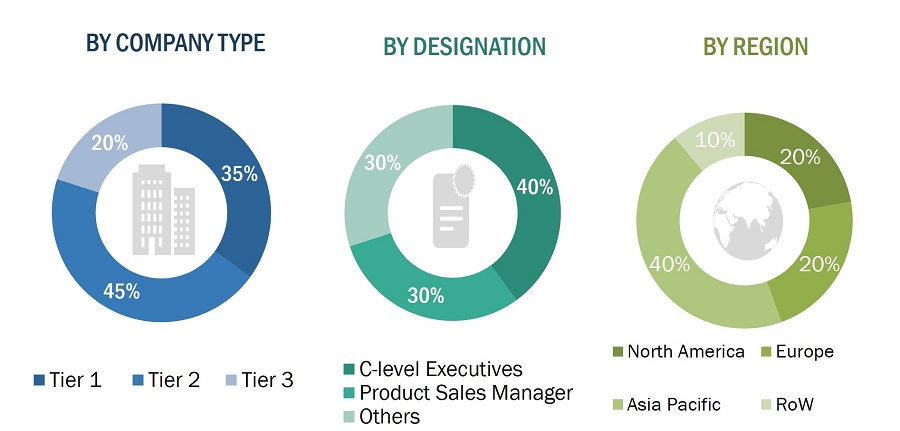
To know about the assumptions considered for the study, download the pdf brochure
Market Size Estimation
The bottom-up procedure has been employed to arrive at the overall size of the fault detection and classification market.
- Analyzing the average selling price of fault detection and classification systems based on different technologies used in different products.
- Arriving at the market estimates by analyzing the revenue of companies and then combining these figures to arrive at the market size.
- Studying various paid and unpaid sources, such as annual reports, press releases, white papers, and databases, to gather the required information.
- Tracking the ongoing developments and identifying the upcoming ones in the market that include investments, research and development activities, product launches, collaborations, and partnerships undertaken, as well as forecasting the market based on these developments and other critical parameters.
- Carrying out multiple discussions with the key opinion leaders to understand the fault detection and classification technologies and related raw materials, as well as products designed and developed to analyze the break-up of the scope of work carried out by the key companies manufacturing panels.
- Verifying and cross-checking the estimate at every level through discussions with key opinion leaders such as chief executives (CXOs), directors, and operation managers, and finally with the domain experts in MarketsandMarkets
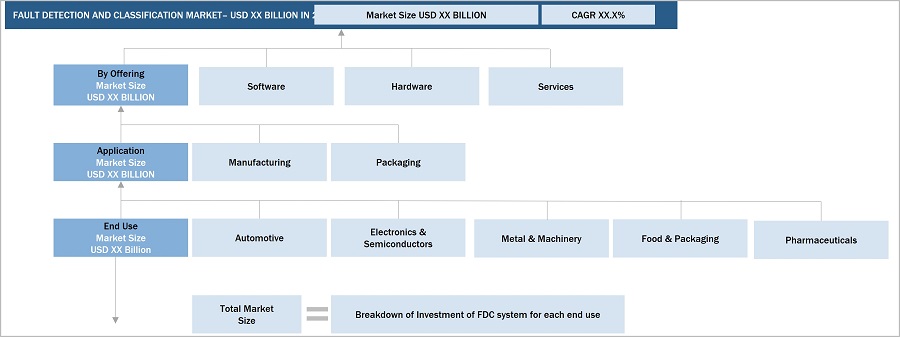
The top-down approach has been used to estimate and validate the total size of the fault detection and classification market.
- Focusing on top-line investments and expenditures being made in the ecosystems of various end users.
- Calculating the market size considering revenues generated by major players through the cost of the fault detection and classification systems.
- Segmenting each application of fault detection and classification in each region and deriving the global market size based on region.
- Acquiring and analyzing information related to revenues generated by players through their key product offerings.
- Conducting multiple on-field discussions with key opinion leaders involved in the development of various fault detection and classification offerings.
- Estimating the geographic split using secondary sources based on various factors, such as the number of players in a specific country and region and the types of fault detection and classification technology used in automotive, electronics and semiconductor, metals & machinery, food & packaging and pharmaceuticals

Data Triangulation
After arriving at the overall market size-using the market size estimation processes as explained above-the market has been split into several segments and subsegments. To complete the entire market engineering process and arrive at the exact statistics of each market segment and subsegment, data triangulation and market breakdown procedures have been employed, wherever applicable. The data has been triangulated by studying various factors and trends from the demand and supply sides in the fault detection and classification market.
Market Definition
Fault detection and classification is an important part of the manufacturing process. The initial detection of faults or defects and the removal of the aspects that may produce them are essential to improve product quality and reduce the economic impact caused by defective products. Modern-day fault detection and classification systems use sensor data analysis, machine learning algorithm and statistical methods for instant identification of defective or anomalous defects on complex surfaces, which helps manufacturers reduce costs and meet consumer quality expectations.
Key Stakeholders
- Brand Product Manufacturers/Original Equipment Manufacturers (OEMs)/Original Device Manufacturers (ODMs)
- Fault detection and classification System Manufacturers
- Semiconductor Component Suppliers/Foundries
- fault detection and classification Material and Component Suppliers
- Manufacturing Equipment Suppliers
- System Integrators
- Technology/IP Developers
- Consulting and Market Research Service Providers
- Fault detection and classification and Material-related Associations, Organizations, Forums, and Alliances
- Venture Capitalists and Startups
- Research and Educational Institutes
- Distributors and Resellers
- End Users
Report Objectives
- To describe and forecast the size of the fault detection and classification market, based on offering, application, and end use
- To describe and forecast the market size of various segments across four key regions—North America, Europe, Asia Pacific, and Rest of the World (RoW), in terms of value
- To describe the technology and fault type in fault detection and classification
- To provide detailed information regarding the drivers, restraints, opportunities, and challenges influencing the growth of the fault detection and classification market
- To provide an overview of the value chain pertaining to the augmented and virtual reality in education ecosystem, along with the average selling price of fault detection and classification devices
- To strategically analyze the ecosystem, regulatory landscape, patent landscape, Porter’s five forces, import and export scenarios, trade landscape, and case studies pertaining to the market under study
- To strategically analyze micromarkets1 with regard to individual growth trends, prospects, and contributions to the overall market
- To analyze opportunities in the market for stakeholders by identifying high-growth segments
- To provide details of the competitive landscape for market leaders
- To analyze strategies, such as product launches and developments, acquisitions, investment, partnerships, collaborations, and expansion were adopted by players in fault detection and classification market
- To profile key players in the fault detection and classification market and comprehensively analyze their market ranking based on their revenue, market share, and core competencies2
Available customizations:
With the given market data, MarketsandMarkets offers customizations according to the specific requirements of companies. The following customization options are available for the report:
- Detailed analysis and profiling of additional market players based on various blocks of the supply chain











Growth opportunities and latent adjacency in Fault Detection and Classification (FDC) Market